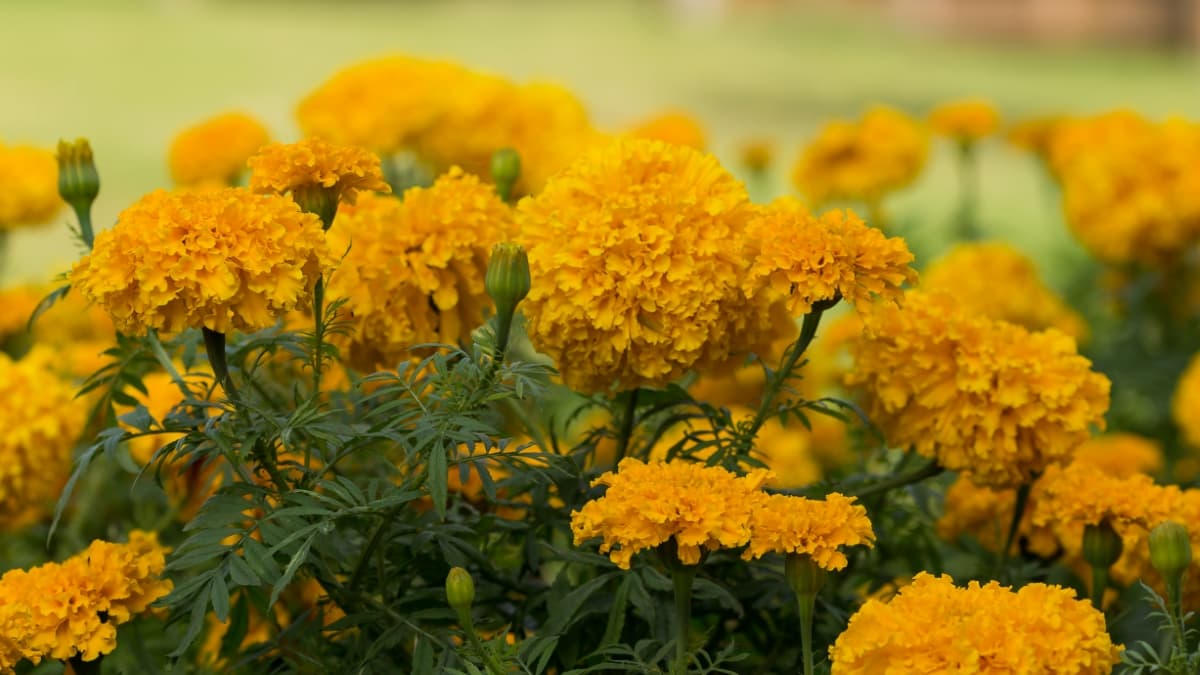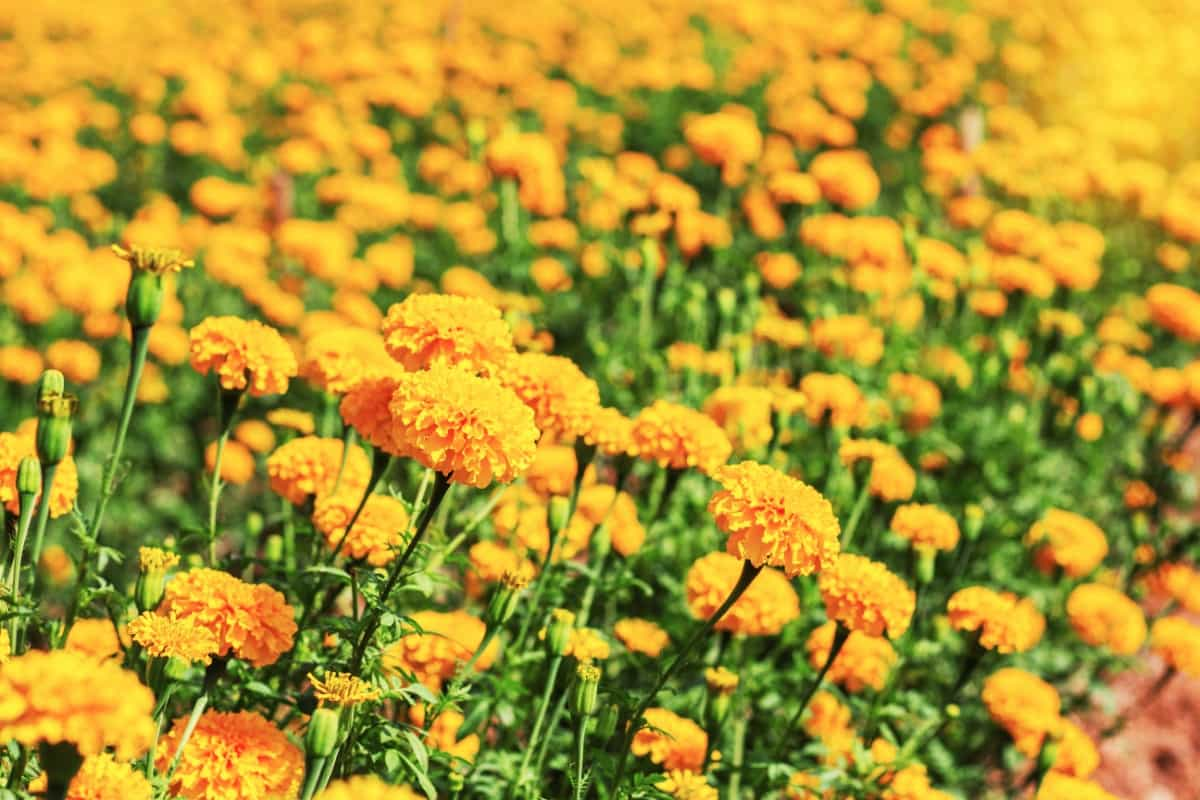Marigolds, vibrant annual flowers, follow a distinct life cycle. Germination, triggered by warmth and moisture, takes about five to 10 days. Rapid growth and leaf development occur during the vegetative stage, lasting 3-5 weeks. Following this, the plant enters the flowering stage, showcasing its iconic gold, orange, or red blossoms. Regular watering and sunlight sustain flower production.

Pollination by insects fosters seed development, taking 40-45 days. Once seeds mature, the marigold plant wilts, completing its life cycle. From germination to seed production, this process spans roughly 90-100 days, showcasing the enduring beauty and brief yet impactful life of marigolds.
Are Marigolds Perennials Or Annuals
Defining Perennials and Annuals: Key Differences in Plant Lifespans
Perennials and annuals are distinct plant types based on their lifespans. Perennials persist for multiple years, often producing flowers and seeds annually. They endure through seasons, regrowing from established root systems. In contrast, annuals complete their lifecycle within a single year.
They germinate, grow, flower, and set seeds for months before dying off. This divergence in lifespans results in varied gardening and ecological impacts. Perennials provide consistent beauty and support ecosystems over time, while annuals offer rapid bursts of color and play crucial roles in reseeding and soil enrichment. Understanding these differences is vital for effective landscape planning and plant management.
Marigolds as Annuals: Characteristics and Growing Requirements
Marigolds (Tagetes spp.) are popular annual flowers known for vibrant yellow, orange, and red hues. They grow well in full sun, well-draining soil, and moderate water. These low-maintenance blossom from late spring to fall. Their pest-repelling properties make them great companions in vegetable gardens.
Marigolds are versatile, suitable for beds, borders, and containers. Regular deadheading encourages continuous blooming. While tolerant of various soils, they prefer slightly acidic to neutral pH. Marigolds are typically grown annually with minimal frost resistance, adding cheerful color to gardens and attracting pollinators.
Marigolds as Perennials: Varieties and Cultivation Tips
Marigolds, typically annuals, can be grown as perennials in warmer climates. Varieties like Tagetes lemmonii and Tagetes lucida are suitable choices. Plant them in soil with well-draining and full sun exposure. Provide regular watering and mulching to retain moisture. Prune faded flowers to encourage new growth. Apply balanced fertilizer during the growing season. Protect from extreme cold and frost. Marigolds as perennials can offer vibrant blooms year after year with proper care.
Factors Influencing Marigold Lifespan: Climate, Soil, and Care
Marigolds thrive in warm climates, but excessive heat can shorten their lifespan. Well-draining soil with proper nutrient levels supports healthy growth. Adequate watering and avoiding waterlogged conditions are crucial. Regular deadheading of spent blooms encourages prolonged flowering. Protection from harsh winds and pests is important. Marigolds are often treated as annuals in cooler climates due to frost sensitivity. A balanced approach to climate adaptation, soil maintenance, and attentive care maximizes marigold longevity and vibrant blooms.
In case you missed it: How to Pollinate Marigold Flowers: Techniques for Hand and Natural Pollination

Understanding Marigold Seeds: Germination and Propagation Methods
Marigold seeds require optimal conditions for successful germination. Start sowing them indoors a few weeks before the last frost, using well-draining soil. The seeds germinate well when the temperature ranges between 18-30°C. Sow seeds below the surface and keep the soil moist but not waterlogged. Germination usually takes 5-10 days. Transplant seedlings outdoors after the last frost.
For propagation, marigolds can also be grown from cuttings. Take 3-4 inch cuttings from healthy plants, remove the lower leaves, and place them in moist soil. Please keep them in a shaded area until roots develop. Alternatively, established plants can self-seed if allowed to flower and produce seeds. Regular deadheading encourages prolonged blooming.
Overwintering Marigolds: Strategies for Perennial Growth
- Begin by selecting hardy marigold varieties known for better cold tolerance.
- As temperatures start to drop in fall, trim the plants back to about half their height, removing dead foliage and spent blooms.
- Apply an organic mulch with materials like straw or shredded leaves around the plant’s base to insulate the soil and provide protection from freezing temperatures.
- Marigolds can be covered with frost cloth or burlap in regions with milder winters to shield them from extreme cold.
- Alternatively, carefully dig up established marigold plants, preserve their root systems, and transplant them into pots.
- Place these pots in a cool, well-lit indoor location, like a basement or garage, where temperatures stay above freezing but remain cool.
- Water the plants sparingly during this dormancy period.
- Regularly check for signs of growth, and as the last frost passes in spring, gradually acclimate the marigolds to outdoor conditions.
- Replant them in well-draining soil, ensuring they receive adequate sunlight and moisture as they awaken from dormancy.
Are French Marigolds Perennials?
No, French marigolds (Tagetes patula) are not considered perennials. They are typically treated as annual plants in most gardening contexts. This means that they complete their lifecycle within one growing season. French marigolds are often planted in the spring, bloom throughout the summer, and then die off with the arrival of cold weather in the fall.
In case you missed it: How to Start Marigolds in Pots: Best Practices for Growing From Seeds and Transplants

Are African Marigolds Perennials?
No, African marigolds (Tagetes erecta) are not perennials; they are annual plants. This means they complete their entire life cycle, from germination to flowering and seed production, within a single growing season. After flowering and producing seeds, African marigolds will typically die off. However, these plants are often treated as annuals in many gardening contexts. They are not reliably winter-hardy in colder climates and are generally grown as decorative annual flowers in gardens, containers, and beds.
Are Crackerjack Marigolds Annuals or Perennials?
Crackerjack Marigolds (Tagetes erecta ‘Crackerjack’) are typically considered annual plants. This means that they complete their entire life cycle within one growing season. They germinate, grow, flower, produce seeds, and then die off, all in one year. While some marigold varieties might self-sow and reappear in subsequent years, Crackerjack Marigolds are generally treated as annuals and replanted yearly for consistent blooms.
Benefits of Growing Marigolds as Annuals or Perennials
- Pest Repellent: Marigolds emit a strong scent that deters many garden pests, reducing the need for chemical insecticides.
- Soil Enrichment: Their root system improves soil structure and health by preventing soil-borne diseases and enhancing aeration.
- Companion Planting: Planting marigolds alongside vegetables can enhance their growth by deterring harmful insects and attracting beneficial ones.
- Vibrant Color: Marigolds’ bright and diverse blooms add a pop of color to any garden, enhancing its visual appeal.
- Low Maintenance: These hardy plants are easy to grow, requiring minimal care while thriving in various soil and climate conditions.
- Edible Uses: Some marigold varieties are edible and can be used to garnish salads or steeped for herbal tea.
- Medicinal Properties: Marigolds have been used in traditional medicine for their anti-inflammatory and skin-soothing properties.
- Cut Flowers: Marigolds make long-lasting cut flowers, adding beauty to indoor arrangements.
- Pollinator Attraction: The flowers attract bees, butterflies, and other pollinators, promoting biodiversity in the garden.
Popular Marigold Varieties: Annual Vs. Perennial Options
| Annual Marigold Varieties | Perennial Marigold Varieties |
| crackerjack | Mexican Marigold |
| Inca II | Lemmon’s Marigold |
| Bonanza | Mountain Marigold |
| Durango | Marsh marigold |
| Disco | Desert marigold |
| Queen Sophia | Pot marigold |
| Lemon Gem | Mexican tarragon |
In case you missed it: How to Grow Marigold in Greenhouse: A Step-By-Step Guide for Seed to Harvest

Conclusion
In summary, when it comes to marigolds, the majority are grown as annuals, but some species can be cultivated as perennials in suitable conditions. It’s important to research the type of marigold you have or plan to grow to determine whether it’s annual or perennial in your region.
- Feed Your Flock for Less: Top 10 Tips to Save on Chicken Feed
- Ultimate Guide to Ossabaw Island Hog: Breeding, Raising, Diet, and Care
- Hatching Answers: The Top 10 Reasons Your Chickens Aren’t Laying Eggs
- Eggs and Economics: Breaking Down the Cost of Raising Backyard Chickens
- Defend Your Greens: Proven Methods to Keep Iguanas Out of Your Garden
- Ultimate Guide to Cinnamon Queen Chicken: A Comprehensive Guide for Beginners
- Ultimate Guide to California Tan Chicken: Breeding, Raising, Diet, Egg-Production and Care
- Ultimate Guide to Marsh Daisy Chicken: Breeding, Raising, Diet, and Care
- 10 Types of Chicken Farming Businesses You Can Start for Profits